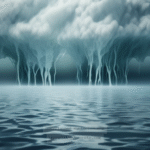What Causes the Unexplained Phenomenon of Ball Lightning?
What Causes the Unexplained Phenomenon of Ball Lightning?
Ball lightning has baffled scientists and laypeople alike for centuries. This mysterious atmospheric electrical phenomenon presents as glowing, spherical objects that can hover, move, or even explode, often during thunderstorms. Despite numerous sightings and anecdotal reports, researchers have struggled to provide a definitive explanation for its occurrence. Understanding ball lightning not only challenges our grasp of physics but also holds potential implications for future technological advancements and safety measures. This post delves into the enigma of ball lightning, exploring its historical context, scientific theories, documented cases, and ongoing research.
Historical Context of Ball Lightning
The phenomenon of ball lightning isn’t a modern curiosity; it has been documented since ancient times. Historical accounts of ball lightning date back to the 19th century, with reports from people across the globe. For instance, the renowned scientist Thomas Edison claimed to have witnessed ball lightning, describing it as a “floating sphere of light.” Such historical references underline the widespread nature of the phenomenon, yet it remains elusive to scientific understanding. One of the earliest documented cases comes from 1638 when the astronomer Johannes Kepler recorded an incident involving a glowing ball that appeared during a thunderstorm.
- 1638: Johannes Kepler describes a glowing sphere during a storm.
- 19th Century: Thomas Edison reports witnessing ball lightning.
Core Concepts Behind Ball Lightning
Ball lightning typically appears during thunderstorms, leading many scientists to associate it with electrical activity in the atmosphere. The core concepts surrounding this phenomenon include its properties, behaviors, and conditions for formation. Most commonly reported characteristics include:
- Spherical shape, often described as glowing or illuminating.
- Sizes ranging from a few centimeters to several meters in diameter.
- Duration of a few seconds to several minutes.
- Movement that can be erratic, sometimes defying gravity.
One prevalent theory suggests that ball lightning results from the combustion of silicon particles released during lightning strikes. When lightning strikes the ground, it vaporizes silicon-containing minerals, and as these particles aggregate in the air, they can create glowing spheres. However, this theory remains speculative, as controlled laboratory recreations have yet to produce convincing examples of ball lightning.
Scientific Theories and Models
Various scientific theories have been proposed to explain the phenomenon of ball lightning. While none have achieved universal acceptance, they offer intriguing insights. Here are some of the leading theories:
- Plasma Formation: Some researchers propose that ball lightning could be a form of plasma, which is a state of matter consisting of charged particles. This theory suggests that the energy from a lightning strike could ionize the surrounding air, creating a stable plasma ball.
- Quantum Tunneling: Another theory posits that ball lightning could arise from quantum tunneling effects, where energy is transferred through barriers that classical physics would deem insurmountable. This hypothesis suggests that ball lightning might exist in a superposition of states, enabling its unusual behaviors.
- Chemical Reactions: Some explanations focus on specific chemical reactions involving nanostructures and aerosol particles in the atmosphere. This theory speculates that as certain compounds mix in the air, they can produce glowing spheres.
- Plasma Formation
- Quantum Tunneling
- Chemical Reactions
Documented Cases of Ball Lightning
Several well-documented cases of ball lightning have emerged over the years. Here are a few notable examples:
- 1956 – The Great Ball Lightning Incident: In a small village in the Soviet Union, residents reported seeing a massive ball of light float through the village before exploding, causing damage to nearby structures.
- 1980 – The Amperes Case: During a thunderstorm in France, a group of researchers observed a ball of light that seemed to react to their movements, moving closer as they approached, only to vanish suddenly.
- 2012 – The Moscow Incident: A video surfaced showing a glowing sphere moving erratically through the streets of Moscow during a storm. The footage sparked renewed interest and controversy over the nature of ball lightning.
Practical Implications and Evidence
Understanding ball lightning has profound implications, particularly in safety and technology. For example, if ball lightning can be replicated or harnessed, it could lead to advancements in energy storage or even new forms of propulsion. Furthermore, recognizing the phenomenon can help in developing safety protocols for those living in areas prone to thunderstorms.
Several scientific experiments have attempted to replicate ball lightning under controlled conditions. Researchers at the University of California, Berkeley, used a plasma-generating device to create small, glowing spheres that exhibit some properties of ball lightning. While these experiments are promising, they have yet to yield a comprehensive understanding of the phenomenon.
- Potential advancements in energy storage.
- Development of safety protocols for thunderstorms.
Alternative Perspectives on Ball Lightning
While scientific investigations focus on physical explanations, alternative perspectives often arise in popular culture and folklore. Some believe ball lightning is a manifestation of supernatural forces or paranormal activity. This viewpoint is particularly prevalent in rural areas, where the phenomenon is often associated with ghost stories or mythical creatures. However, it’s essential to differentiate between anecdotal evidence and scientific investigation when discussing ball lightning.
Common Misconceptions and Clarifications
Several misconceptions exist surrounding ball lightning, often stemming from a lack of understanding of electrical phenomena. Here are some common myths and their clarifications:
- Myth: All glowing spheres in the sky are ball lightning. Fact: Many atmospheric phenomena, such as St. Elmo’s fire or sprites, can appear similar but are entirely different phenomena.
- Myth: Ball lightning can be captured and stored. Fact: Current scientific understanding suggests that ball lightning is transient and cannot be contained like other forms of energy.
- Not all glowing spheres are ball lightning.
- Ball lightning cannot be captured or stored.
Best Practices for Investigation or Study
For those interested in studying ball lightning, whether as scientists or amateur enthusiasts, several best practices should be observed:
- Document sightings meticulously, noting time, location, weather conditions, and any accompanying phenomena.
- Use technology such as high-speed cameras or drones to capture visual evidence of ball lightning.
- Collaborate with meteorological organizations to gather data on storm conditions during reported sightings.
Future Developments and Ongoing Research
The quest to understand ball lightning continues, with researchers exploring new technologies and theories. As experimental techniques improve, there is hope that the elusive phenomenon may become more comprehensible. Ongoing research seeks to unravel the underlying mechanisms of ball lightning, potentially leading to new discoveries in plasma physics, energy manipulation, or atmospheric science.
- Advancements in experimental techniques for studying plasma.
- Interdisciplinary collaboration to explore atmospheric phenomena.
Conclusion
The mystery of ball lightning remains one of the most compelling scientific enigmas of our time. Despite centuries of observation and various theories, a comprehensive understanding eludes researchers. As technology advances and interdisciplinary studies grow, there may finally be answers to the questions surrounding ball lightning. With ongoing research and a willingness to explore unconventional explanations, the scientific community takes a step closer to unraveling this atmospheric mystery. In the meantime, the phenomenon serves as a reminder of nature’s complex and often unexplainable beauty.
Other Articles
Recent Posts
- What Happened to Flight MH370? The Conspiracy Theories That Still Haunt Us
- What Secrets Lurk Within the Walls of the Infamous Trans-Allegheny Lunatic Asylum?
- What Evidence Supports the Existence of Bigfoot in the Pacific Northwest?
- What Happened to the Indus Valley Civilization? Unraveling the Mysteries of Ancient Urban Life
- Can Telepathy Be Scientifically Proven Through Laboratory Evidence?







